Arctic Animals - There is a greater variety of animals in the Arctic than the Antarctic. The North Pole is sea surrounded by the land masses of North America, Europe and Asia so there is a land connection to the south. This means that far more land animals can reach the far north in the warmer months and migrate south again when it gets cold again.
Arctic Animals - Quick-Look
An illustrated overview -
more quick looks
A brief introduction to a range of animals that live
in the Arctic North. 15 images with simple captions
and links to the larger picture page as a slide-show.
Arctic animals in more detail
Slide Pack -
Start slideshow here
 1 - Polar Bears and the world's largest land predator,
they spend most of their lives in the far north where
they hunt on sea-ice.
1 - Polar Bears and the world's largest land predator,
they spend most of their lives in the far north where
they hunt on sea-ice.
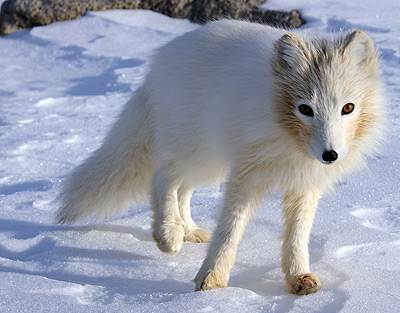 2 - The Arctic Fox lives further
north than trees can grow, they have two coats a year,
a thick white winter one and a thinner grey-brown summer
one.
2 - The Arctic Fox lives further
north than trees can grow, they have two coats a year,
a thick white winter one and a thinner grey-brown summer
one.
 3
- The Arctic Wolf, also known as Polar Wolf or White
Wolf is closely related to other wolves, their fur is
often white but may be quite grey in some individuals.
3
- The Arctic Wolf, also known as Polar Wolf or White
Wolf is closely related to other wolves, their fur is
often white but may be quite grey in some individuals.
 4 - Bearded Seals have large numerous whiskers that
help them find food in soft bottom sediments.
4 - Bearded Seals have large numerous whiskers that
help them find food in soft bottom sediments.
 5
- Arctic Hares are another animals with a thick
white coat for winter and a thinner brown one for summer,
those that live the furthest north have a white one
year round.
5
- Arctic Hares are another animals with a thick
white coat for winter and a thinner brown one for summer,
those that live the furthest north have a white one
year round.
 6 - Narwhals have a long straight twisted tusk developed
from a tooth, in the past people thought that narwhal
tusks came from unicorns.
6 - Narwhals have a long straight twisted tusk developed
from a tooth, in the past people thought that narwhal
tusks came from unicorns.
 7 - This animal is named Reindeer in Europe and
Caribou in North
America, these are the only deer where both males and
females have antlers, they have been herded by humans
for thousands of years.
7 - This animal is named Reindeer in Europe and
Caribou in North
America, these are the only deer where both males and
females have antlers, they have been herded by humans
for thousands of years.
 8 - Musk oxen are more closely related to sheep
than oxen, they live in some of the coldest places in
the Arctic.
8 - Musk oxen are more closely related to sheep
than oxen, they live in some of the coldest places in
the Arctic.
 9
- Arctic woolly bear moth caterpillars spend most
of their lives frozen, they are active for just a few
weeks in the summer, after about seven years, they become
a moth which lives for a weeks or months only.
9
- Arctic woolly bear moth caterpillars spend most
of their lives frozen, they are active for just a few
weeks in the summer, after about seven years, they become
a moth which lives for a weeks or months only.
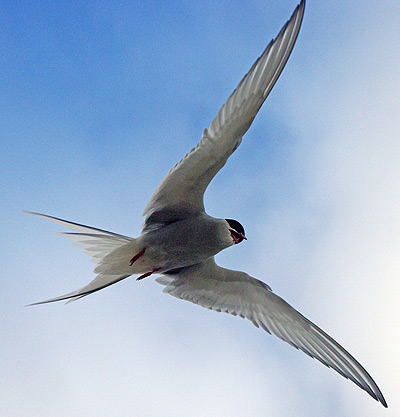 10
- Arctic terns fly from one pole to the other and
back again every year spending the summer in each, they
see more daylight than any other animal on earth.
10
- Arctic terns fly from one pole to the other and
back again every year spending the summer in each, they
see more daylight than any other animal on earth.
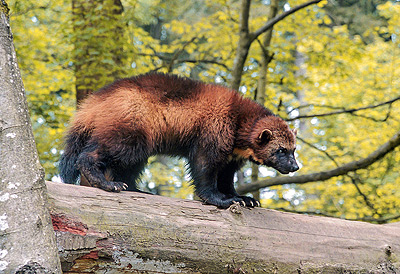 11
- Wolverines are related to weasels though look
like small bears, they are known for being tough and
strong.
11
- Wolverines are related to weasels though look
like small bears, they are known for being tough and
strong.
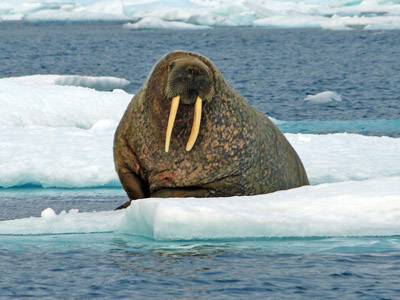 12 - Walruses are very large seals with two large
tusks they can use to help them climb out of the sea
onto ice.
12 - Walruses are very large seals with two large
tusks they can use to help them climb out of the sea
onto ice.
 13
- The Bald Eagle is an American icon, it is found
across most of Canada and Alaska in the north too, it
isn't actually bald, but has a white head.
13
- The Bald Eagle is an American icon, it is found
across most of Canada and Alaska in the north too, it
isn't actually bald, but has a white head.
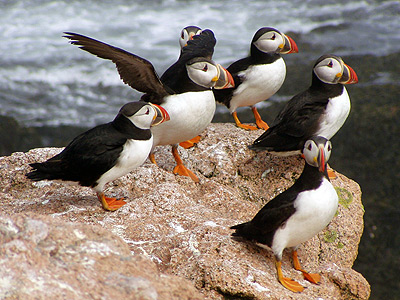 14
- Puffins are small seabirds that nest in burrows
or rock crevices in colonies, their beaks become brightly
coloured in the breeding season.
14
- Puffins are small seabirds that nest in burrows
or rock crevices in colonies, their beaks become brightly
coloured in the breeding season.
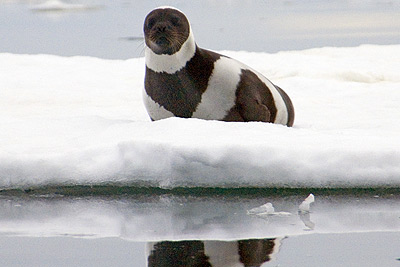 15
- The Ribbon Seal is very clearly marked with black
fur and wide white markings, it lives in the Pacific
Ocean region of the Arctic.
15
- The Ribbon Seal is very clearly marked with black
fur and wide white markings, it lives in the Pacific
Ocean region of the Arctic.
Picture credits: Arctic fox - Algkalv,
under creative commons, attribution 3.0 licence / Arctic wolf
- tsaiproject, used under creative commons, 2.0 licence / Arctic
hare - Steve Sayles, used under creative commons attribution
2.0 generic license. / Musk oxen - U.S. Fish and Wildlife
Service, used under creative commons attribution 2.0 license.
/ Woolly bear moth caterpillar - Mike-Beauregard, used under
creative commons, 2.0 licence. / Wolverine - William F Wood,
used under creative commons, attribution 4.0 share-alike international
licence.
 1 - Polar Bears and the world's largest land predator,
they spend most of their lives in the far north where
they hunt on sea-ice.
1 - Polar Bears and the world's largest land predator,
they spend most of their lives in the far north where
they hunt on sea-ice.
 2 - The Arctic Fox lives further
north than trees can grow, they have two coats a year,
a thick white winter one and a thinner grey-brown summer
one.
2 - The Arctic Fox lives further
north than trees can grow, they have two coats a year,
a thick white winter one and a thinner grey-brown summer
one.
 3
- The Arctic Wolf, also known as Polar Wolf or White
Wolf is closely related to other wolves, their fur is
often white but may be quite grey in some individuals.
3
- The Arctic Wolf, also known as Polar Wolf or White
Wolf is closely related to other wolves, their fur is
often white but may be quite grey in some individuals.
 4 - Bearded Seals have large numerous whiskers that
help them find food in soft bottom sediments.
4 - Bearded Seals have large numerous whiskers that
help them find food in soft bottom sediments.
 5
- Arctic Hares are another animals with a thick
white coat for winter and a thinner brown one for summer,
those that live the furthest north have a white one
year round.
5
- Arctic Hares are another animals with a thick
white coat for winter and a thinner brown one for summer,
those that live the furthest north have a white one
year round.
 6 - Narwhals have a long straight twisted tusk developed
from a tooth, in the past people thought that narwhal
tusks came from unicorns.
6 - Narwhals have a long straight twisted tusk developed
from a tooth, in the past people thought that narwhal
tusks came from unicorns.
 7 - This animal is named Reindeer in Europe and
Caribou in North
America, these are the only deer where both males and
females have antlers, they have been herded by humans
for thousands of years.
7 - This animal is named Reindeer in Europe and
Caribou in North
America, these are the only deer where both males and
females have antlers, they have been herded by humans
for thousands of years.
 8 - Musk oxen are more closely related to sheep
than oxen, they live in some of the coldest places in
the Arctic.
8 - Musk oxen are more closely related to sheep
than oxen, they live in some of the coldest places in
the Arctic.
 9
- Arctic woolly bear moth caterpillars spend most
of their lives frozen, they are active for just a few
weeks in the summer, after about seven years, they become
a moth which lives for a weeks or months only.
9
- Arctic woolly bear moth caterpillars spend most
of their lives frozen, they are active for just a few
weeks in the summer, after about seven years, they become
a moth which lives for a weeks or months only.
 10
- Arctic terns fly from one pole to the other and
back again every year spending the summer in each, they
see more daylight than any other animal on earth.
10
- Arctic terns fly from one pole to the other and
back again every year spending the summer in each, they
see more daylight than any other animal on earth.
 11
- Wolverines are related to weasels though look
like small bears, they are known for being tough and
strong.
11
- Wolverines are related to weasels though look
like small bears, they are known for being tough and
strong.
 12 - Walruses are very large seals with two large
tusks they can use to help them climb out of the sea
onto ice.
12 - Walruses are very large seals with two large
tusks they can use to help them climb out of the sea
onto ice.
 13
- The Bald Eagle is an American icon, it is found
across most of Canada and Alaska in the north too, it
isn't actually bald, but has a white head.
13
- The Bald Eagle is an American icon, it is found
across most of Canada and Alaska in the north too, it
isn't actually bald, but has a white head.
 14
- Puffins are small seabirds that nest in burrows
or rock crevices in colonies, their beaks become brightly
coloured in the breeding season.
14
- Puffins are small seabirds that nest in burrows
or rock crevices in colonies, their beaks become brightly
coloured in the breeding season.
 15
- The Ribbon Seal is very clearly marked with black
fur and wide white markings, it lives in the Pacific
Ocean region of the Arctic.
15
- The Ribbon Seal is very clearly marked with black
fur and wide white markings, it lives in the Pacific
Ocean region of the Arctic.
